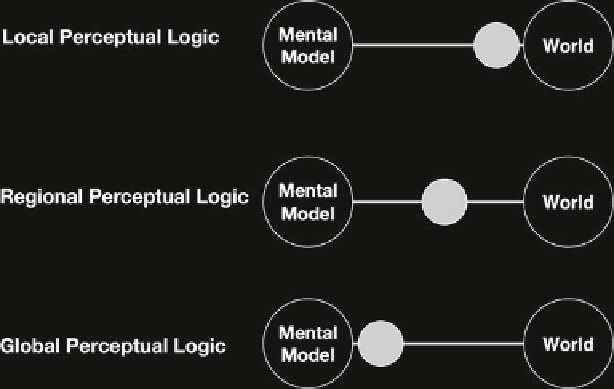Information Technology Reference
In-Depth Information
Fig. 7.6
The layers of perceptual logic: The position of awareness (
gray ball
) on the spectrum of
cognition corresponds to the layer of perceptual logic the system uses
conceptual abstraction (global being the most complex). Since each layer is more
complex than the next, we found the most effective implementation strategy to be
implementing them progressively in stages starting with the most basic local layer
of perceptual logic.
Local perceptual logic considers granular details of the user's contributions, such
as individual lines added to a drawing. Regional perceptual logic, on the other hand,
groups the user's inputs into regions and containers based on principles of gestalt
grouping, such as proximity, similarity, common fate, and continuity (Arnheim
1954
). The principles of gestalt grouping were encoded into this layer of perceptual
logic to provide a means for the system to begin to make sense of creative contribu-
tions in a similar way as humans.
Global perceptual logic considers the creative artifact as a whole, like when an
artist takes a step back from their painting. This form of perceptual logic considers
the relationship between the different regions of the drawing to analyze the overall
composition. When this perceptual logic is applied, the system may decide to com-
pletely decouple its contribution from the human's recent input, i.e., it can select
non-active regions of the artifact on which to operate if those regions present signifi -
cant creative opportunities. For example, a drawing system might examine the over-
all composition and determine that the left side of the drawing is imbalanced because
it has signifi cantly less lines overall than the right side of the drawing. The system
employs global perceptual logic to reason about the drawing as a whole and set a
directive of “do work on the left-hand side of the drawing.” After this directive is
determined, the system would then employ either regional or local perceptual logic
to determine the exact lines to draw on the left-hand side of the page. The directive
therefore constrains the possible actions the system could potentially take and
guides interaction going forward, but it does not determine actions in any way,
which is the critical difference between directives and goals.

